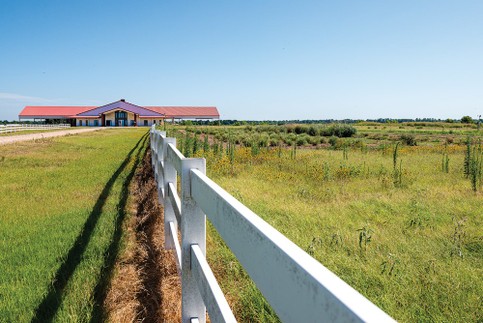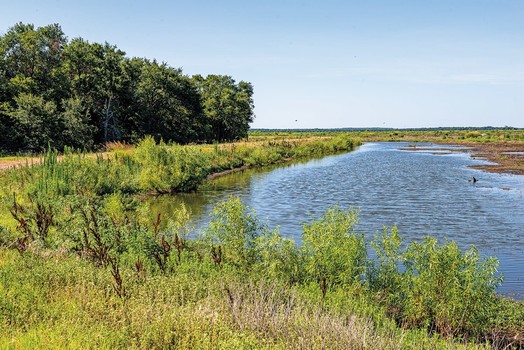On the former Riverby Ranch, the wildlife is coming back. In fact, multiple bird and animal species can be found everywhere across the marshes and native grasslands that make up what used to be a heavily active industrial cattle ranch. Now, populations of native birds, reptiles, pollinator insects, and even small mammals have an area of wildland the size of 13,000 consecutive football fields to call home. Step into the grassland marshes near Fannin County, TX, this spring, and you’ll be welcomed with a symphony of bird songs. This is because of the largest environmental restoration project of its kind in North America.
For more than a century, the area formerly known as Riverby Ranch was an over-grazed, over-farmed cattle ranch. Thirty years ago, North Texas Municipal Water District (NTMWD) was tasked with spearheading the Bois d’Arc Lake reservoir project, which completed construction in the fall of 2022. Mitigation to restore the balance of nature and create a habitat for all of the wildlife creatures who call North Texas home was addressed early in the planning process, with the goal of returning the land to its pre-agricultural state.
Over two summers, University of North Texas (UNT) graduate student Tessa Boucher was monitoring and comparing bird populations across 17,000 acres of reforested wetlands and says the return of bird species signifies success for the project as a whole.
“I’ve found freshly built nests, nests with eggs, and large flocks of juveniles at the end of the season. This is great news because certain birds are species of concern due to habitat loss, but especially in terms of their habitat for breeding,” Tessa reports on her findings.
As the overseer of the Bois d’Arc Lake project, NTMWD collaborated with environmental expert Resource Environmental Solutions (RES) for the Riverby Ranch restoration efforts and took extraordinary care to retool the scorched earth and return thousands of desolate acres to their original, lush condition, planting more than 6 million trees and transitioning nearly 15,000 acres back to forested land.
In addition, the massive environmental restoration project enhanced 8,500 acres of wetlands, planted 3,200 acres of native grassland, and restored 70 miles of streams. One of those streams is Willow Branch Creek which cuts through the center of the ranch area, carrying more than 15 square miles of water that fall within its watershed. Through our contract with RES, NTMWD restored this creek to its original, healthy state, which included reestablishing its wavy, winding shape and healthy riverside profile. The entire creek system had been eroded down to 20 feet below the original floodplain, and in some places, the channel had been eroded as wide as 60 feet. Our restoration put it back on its floodplain and delivered two miles of restored channel system that had been abandoned for decades, slowing the speed of water to ensure it would collect in the wetlands and support wildlife.
After the original riverbed was identified and reestablished, natural materials and native vegetation were strategically placed to help the restored creek bends and curves hold their shape. And when the water returned to the area, so did the fauna. First with the bottom-of-the-chain ecosystems closest to the ground: the insects, worms, crustaceans, and rodents. Then, after some time had passed, the frogs, snails, and amphibians populated the streams and shallow marshes. The snakes came back to eat the frogs, and then the birds followed suit once this food web had expanded.
To measure the success of a restoration project, experts like Jim Bednarz, a senior lecturer on Avian Ecology at UNT, say to look toward the sky. He said, “If the birds—the apex predators—are thriving, it’s a good indication a multitude of species is also healthy within that ecosystem.” More than 100 species of birds have been observed on the wetlands thus far, many of which are of high conservation concern. As the thousands of acres of forest habitats mature, we anticipate the bird population will more than double, bringing with it more mammals as well, such as raccoons, foxes, and bobcats.
By acquiring this ranch, we were able to restore it to a natural utopia. The result of this restoration of trees, rivers, and other habitats is a highly resilient landscape that supports a diverse set of inhabitants, including pollinators, predators, and birds of prey. As a result of our collaborations with other conservation experts and environmentalists, this area of our state will be monitored and studied over the two decades to ensure impeccable stewardship of our shared environmental resources.
Throughout this process, we learned so much about this land and how to adapt to each challenge that arose. Above all, we learned about the power our community has when we come together and listen to people who’ve lived on this land for generations. Since the restoration, we’ve been planting, testing, and measuring so we can provide our findings to the larger Texas ecological and educational community—so future generations and projects can understand what works. This contributes to the overall knowledge of restoration practices that we can share not just locally but globally. We hope the technology and techniques we’ve explored and tested will be able to steward the next ecological project, whatever it may be.
It will take many years to fully understand just how great of an impact this massive restoration project will have. Through our partnerships with RES and UNT, we’ll see how the local bird population is adapting and faring in their new, responsibly stewarded habitat. We’ll also learn how the avian growth on the former Riverby Ranch is compared to nearby areas. We hope to see through our continued collaboration with the environmental sciences that we’ve provided not just a home for hundreds of species of endangered or protected birds but a place to witness the multitude of benefits that are delivered by such a large restoration project.
The Riverby Ranch restoration is an exceptional example of environmental stewardship associated with reservoir development in Texas. Led by NTMWD, it is a vibrant, protected habitat secured for future generations. This is seen and heard as the birds continue to flourish and fly like never before.

